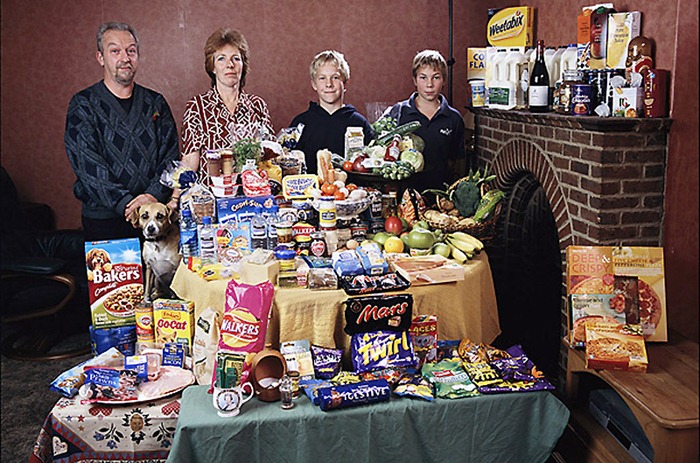In the book Hungry Planet, photographer Peter Menzel and Faith D'Aluisio present a photographic study of families from around the world, revealing what people eat during the course of one week. Each family's profile includes a detailed description of their weekly food purchases; photographs of the family at home, at market, and in their community; and a portrait of the entire family surrounded by a week's worth of groceries.

To assemble this remarkable comparison, Menzel and D'Aluisio traveled to 24 countries and visited 30 families from Bhutan and Bosnia to Mexico and Mongolia, and recorded what they ate for a week. Menzel photographed each family in their kitchen with the week’s worth of groceries, while D’Alusio interviewed them about their food habits and family structure. Accompanying the portraits and narratives are detailed breakdowns of each family’s grocery list, more photographs of the family and home country, and statistics for each country visited.
Here is a selection of pictures from the book. Note: the book was made about 5 years ago, and the prices were of that time.
Japan: Ukita family of Kodaira City
Expenditure on food for one week: 37,699 Yen or $317.25
Favorite foods: sashimi, fruit, cake, potato chips

Italy: Manzo family of Sicily
Expenditure on food for one week: 214.36 Euros or $260.11
Favorite foods: fish, pasta with ragu, hot dogs, frozen fish sticks

Chad: The Aboubakar family of Breidjing Camp
Expenditure on food for one week: 685 CFA francs, or $1.23
Favorite foods: soup with fresh sheep meat

Kuwait: Al-Huggan family of Kuwait City
Expenditure on food for one week: 63.63 dinar or $221.45
Family recipe: Chicken biryani (spicy rice) with basmati rice

United States: The Revis family of North Carolina
Expenditure on food for one week: $341.98
Favorite food: spaghetti, potatoes, chicken with sesame seeds

Mexico: The Casales family of Cuernavaca
Expenditure on food for one week: 1 862.78 Mexican pesos or $189.09
Favorite food: pizza, crab, pasta, chicken

China: The Dong family of Beijing
Expenditure on food for one week: 1 233.76 yuan, or $155.06
Favorite foods: fried shredded pork with sweet and sour sauce

Poland: The Sobczynscy family of Konstancin-Jeziorna
Expenditure on food for one week: 582.48 zlotys, or $151.27
Family recipe: Pig's knuckles with carrots, celery and parsnips

Egypt: The Ahmed family of Cairo
Expenditure on food for one week: 387.85 Egyptian pounds, or $68.53
Family recipe: Okra and mutton

Ecuador: The Ayme family of Tingo
Expenditure on food for one week: $31.55
Family recipe: Potato soup with cabbage

USA: The Caven family of California
Expenditure on food for one week: $159.18
Favorite food: beef stew, berry yogurt sundae, clam chowder, ice cream

Mongolia : The Batsuuri family of Ulaanbaatar
Expenditure on food for one week: 41,985.85 togrogs or $40.02
Family recipe: Mutton dumplings

United Kingdom: The Bainton family of Cllingbourne Ducis
Expenditure on food for one week: 155.54 British Pounds or $253.15
Favorite foods: avocado, mayonnaise sandwich, prawn cocktail, chocolate fudge cake with cream

Bhutan: The Namgay family of Shingkhey Village
Expenditure on food for one week: 224.93 ngultrum or $5.03
Family recipe: Mushroom, cheese and pork

Germany: The Melander family of Bargteheide
Expenditure on food for one week: 375.39 Euros or $500.07
Favorite foods: fried potatoes with onions, bacon and herring, fried noodles with eggs and cheese, pizza, vanilla pudding


[via Time]
Related: What's In Your Refrigerator?












I created a google chart of the life expectancy for each of the countries pictured in this post at
ReplyDeletehttp://thenewportnews.blogspot.com/2010/07/life-expectancy-and-what-we-eat.html
I am very uncomfortable with your (the photographer's) depiction of Africa. Why were other families interviewed in homes and when it came to Africa a refugee camp was seen as the best option? This is simply an example of the continued biased coverage of Africa in international media. If the photographer aimed shoot on level ground, s/he would have at least taken the trouble to visit a home in Africa as well. I assure you, that even in my rural home, the variety of food (grains, vegetables, meats) are much more than rations given at any refugee camp. I do not understand what your (the photographer's) motivation was. Very disappointing.
ReplyDeleteIn the book there are two families from Chad, one from Egypt and one from Mali.
DeleteThose are just a few of the pictures. They also went to Mali, Egypt, and another family in Chad (which was an interesting comparison with the Aboubakar family).
ReplyDeleteAgreed with PatriotAfrican. The vast majority of people live in developed cities - but western publications seem to have a fetish for depicting Africans as all living in refugee camps. Very disappointing to see you further this misconception,
ReplyDeletehey he said in the description that it was from a refugee camp..i think it is pretty acurate and even the homes look traditional
ReplyDeletethe life expectancy link is so wrong how can us be on number 4 with more life expectancy than the others when all they eat is fast food??or britain on number 3??
ReplyDeleteBecause there's more to health than junk food avoidance. You also need a health system. And clean water.
DeleteBecause life expectancy is primary driven by infant mortality.
DeleteThe vast majority of people live in developed cities - but western publications seem to have a fetish for depicting Africans as all living in refugee camps.
ReplyDeleteKüstenpatent,
I thinks over training is not good for the beginners,.
ReplyDeletebut its good for gaining the size and shape of the body but the food is must use according to the workout,.
Very interesting article.
ReplyDeleteI like your post.
http://www.dailymail.co.uk/news/article-2319825/The-great-global-food-gap-Families-world-photographed-weekly-shopping-reveal-cost-ranges-3-20-320.html
ReplyDeleteLooks like the Daily Mail has stolen your article!